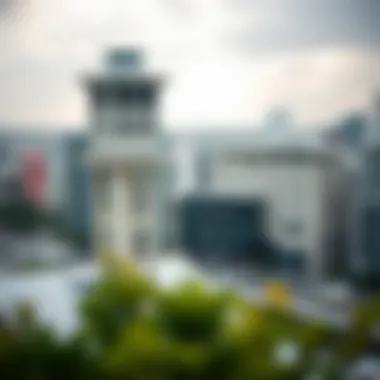The Role of Observation Towers in Urban Settings


Intro
In today’s rapidly evolving urban landscapes, observation towers have emerged not merely as tall structures piercing the skyline but as significant cultural and social landmarks. Especially in cities like Dubai, these towers offer more than just a vantage point; they represent innovation in architecture, acting as focal points for community interaction and tourism. From their historical roots to their modern manifestations, observation towers encapsulate the spirit of exploration, providing unique experiences that marry functionality with aesthetics.
A closer examination of these towers reveals their dual role as both a visual spectacle and a functional space. While they serve to enhance urban identity, they also cater to recreational needs, catering to both residents and visitors alike. This article takes a deep dive into the architectural styles, historical context, and social implications of observation towers, with a keen focus on their impact within the vibrant fabric of urban life in Dubai.
The exploration doesn’t stop there; it goes on to address broader themes such as market trends related to urban development and property investments linked to these iconic structures. Observing how they transform views, provide unique experiences, and influence community dynamics helps in understanding their broader significance.
As we navigate through this insightful journey, it is crucial to recognize the layers of meaning embedded within these towering structures. Their impact stretches beyond aesthetics and economics, intertwining with our social identities and urban narratives.
Understanding Observation Towers
Observation towers hold a unique place in urban environments. These towering structures are more than just points of interest; they symbolize the aspiration and innovation of the cities that host them. Their importance can be viewed from multiple angles, encompassing architectural integrity, social interaction, and economic benefits. Understanding the significance of observation towers allows stakeholders, including investors, homeowners, and urban planners, to appreciate how these structures contribute to a city’s urban identity and community dynamics.
Defining Observation Towers
At their core, observation towers are elevated platforms designed for people to view the surrounding landscape, whether it be a sprawling cityscape, natural beauty, or iconic landmarks. Unlike standard buildings, they prioritize height and visibility, often serving as focal points within urban designs. If one were to consider the characteristics that define an observation tower, several elements come to mind:
- Height: The structure typically surpasses adjacent buildings, providing unparalleled vantage points.
- Accessibility: Featuring observation decks, elevators, and sometimes even restaurants, these towers are built to welcome visitors.
- Architectural Style: They often embody innovative designs and aesthetics, helping to distinguish a city's skyline.
Historical Context
The history of observation towers is as fascinating as any city’s development. From the ancient civilizations that built watchtowers for defense, to the Renaissance period where they became symbols of power and urban sophistication, the evolution of these towers reflects societal changes.
Take, for example, the iconic Tower of Pisa, not originally meant for observation but offering splendid views nonetheless, or the medieval watchtowers in Europe that marked the landscape with their imposing presences. In modern times, the significance of observation towers has shifted towards tourism and urban engagement, especially in burgeoning cities like Dubai, where towers such as the Burj Khalifa symbolize global ambition and cultural pride.
Evolution of Design
The design of observation towers has seen a dramatic transformation over the years. Early towers were practical and utilitarian, primarily serving defensive or navigational purposes. As cities expanded and urbanization progressed, the aesthetic aspects began to surface. Today, design is not solely a function of height but also incorporates artistic flair and sustainability.
Key aspects of contemporary observation tower design include:
- Sustainable Practices: Modern architects prioritize energy-efficient materials and designs that blend with the environment, like the Gherkin in London.
- Technological Integration: Altitude is now paired with advanced technology, offering interactive experiences or augmented reality views of the surroundings.
- Symbolic Architecture: Towers can represent a city’s values or identity, as seen in the Taipei 101’s resemblance to traditional pagodas yet reflecting modern engineering.
Architectural Significance
The architectural significance of observation towers in urban landscapes cannot be overstated. These structures serve not only as vantage points for sightseeing but also as markers of identity and aspiration within cities. In the case of Dubai, such towers manifest the city's ambitions, showcasing how creative design can reshape urban experiences and drive tourism. Importantly, they intertwine functionality with artistry, becoming not just about reaching the heights but how those heights can enhance our experience of place.
Design Principles
To craft a successful observation tower, architects must consider several design principles that affect both its utility and aesthetic appeal. These include:
- Proportions and Scale: The relationship between the tower's height and its surroundings influences how it fits in with the skyline. Too imposing, and it risks overwhelming the other structures; too subtle, and it may go unnoticed.
- Form and Function: The outer design has to reflect its purpose. For instance, a tower meant for public affinity often utilizes curves and organic shapes, creating a visual invitation.
- Environmental Integration: A tower that respects its landscape—by incorporating natural lighting or local materials—can not only reduce energy consumption but also foster a connection between nature and the man-made world.
This meticulous approach ensures that the building is not merely a stand-alone entity but a vital cog in the urban machine, engaging with its space and inhabitants.
Materials and Construction Techniques


The choice of materials and construction techniques employed in building observation towers significantly contributes to their overall durability and visual impact. It involves:
- High-Performance Materials: To withstand wind and seismic activity, many contemporary towers employ advanced materials like reinforced concrete or glass composites, commonly used in the Burj Khalifa. These materials also promote energy efficiency through innovative insulation techniques.
- Sustainable Practices: The adoption of sustainable methods, such as using recycled materials or energy-efficient systems, enhance the ethical dimension of tower construction. Integrating renewable energy sources like solar panels is becoming more commonplace, helping to mitigate the carbon footprint of these towering giants.
- Construction Innovations: Techniques like modular construction allow for quicker assembly without compromising safety. These innovations can influence the economies of tower building, potentially lowering costs for developers while ensuring robust architectural integrity.
Impact on City Aesthetics
Observation towers play a kickass role in shaping the aesthetic landscape and cultural DNA of a city. They function as visual anchors around which urban narratives are built. For instance, the sleek outline of the Musee de l'Orangerie in Paris serves as a beacon of culture as much as it does for art lovers. Such towers influence aesthetics through:
- City Skylines: A well-designed tower has the potential to redefine a city's silhouette. Look at how the Taipei 101 has become an iconic landmark that draws travelers from all walks of life. Its unique design contributes significantly to Taiwan's identity.
- Cultural Symbolism: These towers don’t just scrape the sky; they encapsulate stories and reflect the cultural values and ambitions of their cities. The Eiffel Tower symbolizes Parisian romance and innovation, creating an emotional tie that goes beyond mere architecture.
- Public Spaces: Observation towers often integrate with parks, plazas, and other social spaces, enhancing public interaction and dynamism in urban settings. This interaction enriches the everyday experience of locals and tourists alike, making the urban environment more inviting.
In summary, the architectural significance of observation towers is a multifaceted tapestry. Their role in enhancing the urban skyline, fostering public spaces, and reflecting cultural identity are just a few layers of their complex contribution to city life. Understanding this significance helps stakeholders appreciate the delicate balance between innovation and community integration that these towering structures embody.
Functional Roles of Observation Towers
Observation towers serve more than just the purpose of being landmarks. In urban landscapes, especially in cities like Dubai, these structures have pivotal roles that intertwine with various aspects of social, economic, and emergency dynamics. Understanding these functions is essential for investors, homeowners, and developers as they highlight the comprehensive nature of observation towers beyond mere aesthetics.
Tourism and Visitor Experience
Observation towers are a beacon for tourists. The allure of panoramic views attracts countless visitors, making them hotspots for tourism. For instance, the Burj Khalifa is not merely a tall structure; it’s an experience. People flock to its observation decks to take in breathtaking views of the sprawling city, the desert, and even the Arabian Gulf. This is what optimizes visitor experience; the thrill of height combined with the beauty of the surroundings enhances their sense of adventure and exploration.
Additionally, the designed journey upwards—the ticketing process, the elevators, and the curated experiences within—contributes to a memorable visitor experience. Each element, whether it be informative displays or interactive installations, is crafted to ensure that visitors not only see but also understand the significance of the location.
The function of observation towers in tourism goes beyond offering a view; it creates a multifaceted visitor experience.
Community Interaction Spaces
The role of observation towers as community interaction spaces is often understated. Many towers have designated areas that encourage social gatherings and cultural events. For example, rooftop cafes or viewing platforms can serve as venues for local artists to showcase their work or for community discussions to take place. This transforms these structures into urban hubs where people can connect, thus fostering a sense of belonging and community identity.
Moreover, observing a city from a high vantage point can stir local pride. When residents come together to appreciate their city from above, it nurtures an affinity for the urban landscape they inhabit. In a way, it becomes a shared canvas where memories are born, bridging the gap between towering structures and the stories of the people living below.
Emergency and Surveillance Aspects
From a practical standpoint, observation towers are vital in the realm of safety and surveillance. Their elevated vantage points provide authorities with broader visibility for monitoring urban activities and emergencies. Positioning surveillance cameras at such heights can enhance the effectiveness of crime prevention and urban safety measures.
In addition, during emergencies—be it natural disasters or security threats—these towers serve as crucial command posts. They can be utilized for coordinating response efforts, where professionals can assess the situation from above. The integration of technology in these spaces further amplifies their functional capabilities, allowing real-time reporting and communication, which can be life-saving.
To sum up, observation towers are not only architectural feats but also crucial elements in urban ecosystems. They bring income through tourism, foster community ties, and serve essential purposes in emergency management. For those involved in urban planning and development, the multifunctionality of these structures suggests that their impact permeates deeply into the urban fabric, making them worthy investments for the future.
Economic Impact
Understanding the economic impact of observation towers is vital for comprehending their role in urban ecosystems. These towering structures are not merely visual spectacles; they also serve as critical components of the local economy. They contribute significantly to tourism, create job opportunities, and drive investment in surrounding areas. This section dives into those aspects, highlighting how observation towers can transform local economies into thriving hubs of activity.
Contribution to Local Economy
Observation towers like the Burj Khalifa act as magnets for both tourists and locals, invigorating the local economy in numerous ways. First and foremost, these towers can attract millions of visitors each year, leading to increased spending in restaurants, retail shops, and hotels situated nearby. Businesses often see a notable uptick in patronage when such towering attractions are within proximity; it’s as if the presence of the tower itself creates a lively atmosphere.
- Tourism Revenue: According to Statista, Dubai's tourism sector substantially benefits from its observation towers, generating billions in revenue annually.
- Growth of Local Businesses: Local entrepreneurs can seize opportunities, creating themed cafes, souvenir shops, and guided tours that cater specifically to tower visitors.
- Real Estate Development: The rise of observation towers generally correlates with enhanced property values. As new developments spring up around these landmarks, property owners reap the benefits of increased demand.
Job Creation and Opportunities


The construction and ongoing operation of observation towers can lead to an array of job opportunities, thereby enhancing community livelihoods. During the building phase, thousands of workers may find employment, spanning diverse roles from engineering to construction management.
Once operational, these towers require staff for maintenance, visitor services, security, and hospitality. Large-scale events often held at these venues can further boost employment in sectors such as event management and catering.
- Short-term Opportunities: Construction jobs may be temporary; however, they can provide essential income for many families.
- Long-term Employment: Permanent roles in hospitality, tourism, and facility management continue to evolve, resulting in sustained economic benefits for the community.
- Skill Development: Many towers partner with local institutions for training programs, enhancing the skill set of the workforce.
"Observation towers do not just redefine a skyline; they redefine entire communities, driving both economic vitality and employment potential."
Case Studies of Notable Observation Towers
Case studies of notable observation towers give us unique insights into how these structures influence our urban landscapes. They serve as flagships of architectural innovation, tourism, and community engagement. When examining specific examples like the Burj Khalifa and the Etihad Towers, we analyze not only their physical attributes but also their broader impacts on local economies, culture, and identity. Here, we delve into three significant case studies showcasing these aspects in depth.
Burj Khalifa: A Testament to Innovation
The Burj Khalifa stands as a beacon of human ambition. Rising to a staggering height of 828 meters, it's more than just a tall building; it's a symbol of the possibilities inherent in modern engineering and design. Imagine stepping into a space where the view stretches for miles, almost making one feel like he is standing at the edge of the world. The observation decks offer unrivaled panoramas, tempting tourists and locals alike to indulge in unforgettable vistas.
The Burj Khalifa’s impact on tourism is multifaceted. Visitors flock from around the globe, each yearning to experience its shimmering façade and the luxurious atmosphere. This emotional connection draws people in, fostering a sense of belonging to a global community. Furthermore, the tower has become a photographic favorite, often seen in travel blogs and social media platforms like Instagram, which accentuates its allure.
Challenges and Critiques
The conversation surrounding observation towers extends beyond mere admiration for their architectural feats; it invites a scrutiny of the implications these towering structures have on urban life. While they serve vital functions in aesthetics, tourism, and city identity, they bring along a slew of challenges and critiques that must be addressed. This section explores the environmental concerns, cultural sensitivity, and regulatory limitations associated with these urban monuments.
Environmental Concerns
Observation towers, despite their grandeur, often gaze down upon ecosystems that bear the brunt of urbanization. Constructing these massive structures can disrupt local wildlife habitats, lead to increased carbon footprints due to construction activities, and elevate energy consumption during their operation.
Some of the primary environmental issues include:
- Habitat Disruption: Many towers are built in areas previously untouched by heavy construction. This can lead to the displacement of native species and alteration of local ecosystems.
- Resource Intensity: The materials used, such as steel and glass, require substantial energy inputs for extraction and processing. As cities strive for sustainability, this raises questions about the carbon offset of such constructions.
- Light and Noise Pollution: Observation towers can create significant light and noise, affecting both wildlife and the quality of life for residents nearby, which is a growing concern in urban planning.
As future developers explore taller structures, a thorough environmental impact assessment becomes non-negotiable, and measures to mitigate these concerns should be at the forefront of architectural discussions.
Cultural Sensitivity and Local Identity
In a world that is increasingly interconnected, the design and positioning of observation towers must navigate the fine line between innovation and insensitivity to local culture. Observation towers can symbolize the aspirations of a city, but if not aligned with the cultural fabric of the area, they may come off as alien impositions.
Considerations include:
- Symbolism: Towers can mean different things to different people. To some, they embody progress and modernity. To others, they might represent the loss of heritage or neighborhood character.
- Architectural Harmony: New designs must respect existing architectural styles. A modernist skyscraper juxtaposed with traditional buildings can evoke strong local opposition, emphasizing the need for cohesive urban design.
- Community Engagement: A lack of local input in the design process can lead to structures that do not resonate with the identity of the community. Engaging citizens can help authorities build structures that reflect collective aspirations rather than just economic benefits.
Essentially, developers should remain attuned to the nuances of local identity while designing observation towers to foster a positive public perception and respect for community sentiment.
Regulatory and Technical Limitations
Navigating through the maze of regulations and technical constraints poses yet another challenge for observation tower projects. These towers, often exceeding standard building heights, must adhere to a complex web of zoning laws, building codes, and safety regulations that vary from one city to another.
This section covers:
- Height Restrictions: Many cities impose restrictions to protect sightlines, historical sites, or flight paths. Navigating these constraints requires foresight and planning.
- Safety Regulations: Fire safety codes, emergency evacuation protocols, and earthquake resistance need careful consideration in the designing and building phases. Failing to comply with regulations can delay or halt projects.
- Technological Constraints: Incorporating advanced technology, while beneficial for enhancing visitor experiences, can be a double-edged sword. Issues such as high-speed elevators, effective communication systems, and sustainable energy sources need to be examined closely.


In summary, while the allure of observation towers is evident, their successful integration into urban landscapes is fraught with significant challenges. Addressing these critiques not only enhances the sustainability and acceptability of such structures but also fosters a respect for both the environment and the communities they inhabit.
Future of Observation Towers
The concept of observation towers in urban landscapes is evolving rapidly, reflecting changes in societal needs, technological advancements, and environmental considerations. As the world faces increasing urbanization and various challenges related to sustainability, the future of these structures holds significant implications for both urban identity and functionality. The importance of this topic cannot be overstated, particularly for investors, real estate agents, and urban planners who seek to understand how these towers can shape the modern cityscape.
Emerging Trends in Design and Function
Observation towers are moving beyond traditional roles. They now function as multi-use spaces that contribute to the urban experience in diverse ways. Recent designs incorporate elements like open-air observation decks, interactive exhibits, and even urban farms. This shift reflects a desire for spaces that serve not only as viewpoints but also as community hubs.
Some emerging trends include:
- Mixed-Use Developments: Many new towers combine residential, commercial, and recreational spaces, enhancing their appeal.
- Adaptive Reuse: Existing structures are being retrofitted to serve as observation towers, helping preserve historical character while meeting modern needs.
- Vertical Parks: Incorporation of green spaces at various levels promotes environmental sustainability and offers relaxing areas amidst urban hustle.
With these trends, observation towers become integral parts of urban environments, enriching the lives of residents and tourists alike.
Sustainability Innovations
Sustainability is now a cornerstone of modern architecture, and observation towers are no exception. These structures are increasingly designed with eco-friendly technologies aimed at minimizing their environmental impact. Innovations such as solar panels, rainwater harvesting systems, and energy-efficient materials are becoming common.
Key innovations include:
- Green Roofs and Walls: These features improve air quality and provide insulation, while also offering aesthetic green spaces.
- Smart Building Technologies: IoT devices and advanced building management systems help monitor and optimize energy usage.
- Bioswales and Permeable Pavements: These elements manage stormwater runoff effectively, enhancing local ecosystems.
Observation towers embody the commitment to sustainability in modern architecture, serving as beacons of environmental consciousness.
Integrating Technology
The integration of technology into observation towers not only enhances the visitor experience but also streamlines operations. With advancements like augmented reality (AR) and virtual reality (VR), visitors can enjoy immersive experiences that enrich their understanding of the surrounding urban landscape.
Incorporating technology can include:
- Interactive Displays: These offer information about the city’s history, culture and landmarks, engaging visitors on multiple levels.
- Networking with City Infrastructure: Smart observation towers can connect with municipal systems for traffic updates, weather alerts, and more, providing a comprehensive experience.
- Enhanced Safety Features: Surveillance systems and emergency response technology ensure that towers can respond efficiently during crises.
The fusion of technology with design makes observation towers not just viewing points but extensive networks of knowledge and connectivity.
In summary, the future of observation towers lies in their ability to adapt and innovate, aligning with urban needs and environmental standards. These structures are not relics of the past but rather vibrant elements of tomorrow’s urban landscape.
Culmination: Synthesis of Findings
The synthesis of findings in this study highlights the crucial essence that observation towers have in urban landscapes, particularly in cities like Dubai. These structures are not merely aesthetic landmarks; they serve multifaceted roles that engage and transform urban life. Their contribution to city identity is profound, often evoking a sense of pride among residents while attracting millions of visitors eager to experience the views and cultural significance they represent.
The research illustrates that observation towers facilitate a broader understanding of urban ecosystems. They act as beacons of innovation, blending architectural brilliance with functionality. By focusing on specific aspects like tourism, community interaction, and emergency response capabilities, it becomes evident that these towers play an integral role in modern urban planning strategies. Investors and developers must consider these elements when envisioning future projects, ensuring that new endeavors harmonize with existing frameworks.
The Crucial Role in Urban Identity
Observation towers serve as symbols of the city’s aspirations and identity. They embody what a city stands for and reflect its culture, ambitions, and values. For instance, the Burj Khalifa isn’t just the tallest structure; it's a testament to human ingenuity and resilience, showcasing Dubai's leap into global prominence. Such towers often become recognizable icons, thus shaping a city’s image in the eyes of both locals and tourists.
Moreover, these structures are gateways for public engagement, fostering communities around them. They provide landscapes for events, gatherings, and public workshops, integrating the city's operational fabric. Their presence encourages social connectivity, transforming previously underutilized areas into vibrant hubs of activity. For developers, recognizing this social aspect can pivot their projects towards a more communal approach, leading to sustainable development that resonates with the populace.
Recommendations for Future Development
Moving forward, the evolution of observation towers is critical in addressing emerging urban challenges. Here are several recommendations for future development:
- Emphasize Sustainable Practices: Future observation towers must prioritize eco-friendly designs and materials, minimizing their environmental impact. This not only appeals to modern sensibilities but also attracts environmentally-conscious investors.
- Integrate Technology: The incorporation of smart technologies in these structures can enhance visitor experiences while easing operational efficiencies. For instance, incorporating IoT systems for real-time data collection could significantly improve maintenance and visitor engagement.
- Cultural Sensitivity: Developers must be attuned to the cultural narratives of the areas where these towers are constructed. Maintaining local heritage while introducing modern design can strengthen community bonds.
- Multi-Purpose Facilities: Future observation towers should not solely function as viewing platforms but also include mixed-use spaces like restaurants, art galleries, and educational hubs. This diversity in functionality can foster a more holistic urban environment.















